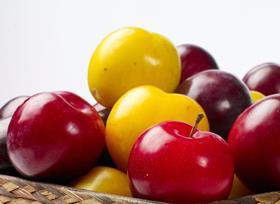
Exports of the three main categories of South African stonefruit are expected to increase this season compared to last year, with shipments of nectarines, peaches and plums forecast to jump 4 per cent, 5 per cent and 3 per cent respectively.
The country is expected to export some 18.8m cartons of stonefruit, with plums at 11.8m cartons dominating the basket. Nectarines, at nearly 4m cartons, have been growing steadily during the past few years and are also now significant contributors to the category's export volumes.
The growth in peaches is attributed to newer and better varieties that been introduced to South Africa in recent years. However, apricots are still lagging behind the other categories – mainly because of a restrictive cultivar base which results in a short picking window.
This year, apricot volumes will again drop slightly, but this is expected to change rapidly in future due to the fast-tracking of a range of later varieties into the industry by two exporters, Fruits Unlimited and Stargrow Marketing. These red-blushed apricots should mean that the South African season will be expanded from end December to the end of March – one of the most significant developments in the national stonefruit sector.
The Stone Fruit Growers’ Association says initial expectations are promising for the new season.
“Good winter and spring conditions contributed to overall good quality, size and sugar levels,' the Association reported. 'Possible water shortages in certain production areas is a cause for concern for later varieties, and water and irrigation management will be crucial to ensure that the crop’s potential is realized.'
Meanwhile, there is concern in the industry that export volumes to Germany were down again last season. In order to address the situation the Association sent its own delegation to the country recently to consult with all sectors of the German trade to find solutions.
“This market remains under pressure, but the tide seems to have turned and volumes are expected to gradually start increasing again,' the Association noted. 'The dynamics and structure of this market have however changed significantly.'
The group said the emphasis had changed from “just stocking and selling stonefruit for the sake of having it on the shelf” to focusing on eating quality and satisfying consumers’ taste preferences.
“Unfortunately the German consumer has been let down too many times in terms of bad experiences in eating quality. This ultimately led to the challenging situation the RSA stonefruit industry is finding itself in. The main reason for this - be it factually correct or not - can be placed on a lack of eating quality in imported stonefruit. This might be poor eating quality stonefruit imported not only from South Africa, but other European and Southern Hemisphere sources over the previous two seasons that disappointed the end consumer.”
The Association said the visit was an effort to build closer trade ties between South Africa and Germany.
“Out-of-season fruit (Southern Hemisphere produce) also has more competition from a broader range of other products like late mandarins that have excellent taste. Consumers have changed their shopping habits, conducting more frequent shopping expeditions per week than in the past, purchasing less at a time and exhibiting an 'instant satisfaction' habit.”
Retailers are clear when saying they would rather not have any stonefruit on their shelves than have poor eating quality fruit available, the group added.
“Early varieties such as Pioneer, African Rose and Sapphire therefore remain under pressure and demand for these cultivars is very weak. The general trend is to start the season later with (perceived) better eating quality fruit and to keep extending the campaign to the later part. The preference is also towards darker coloured plums (purple and black).”



